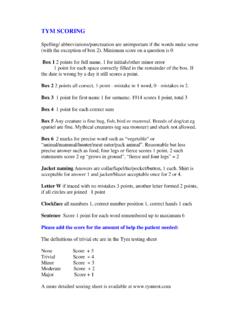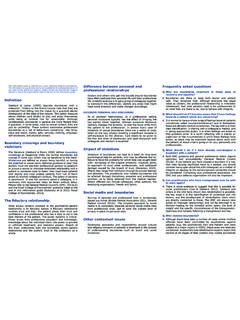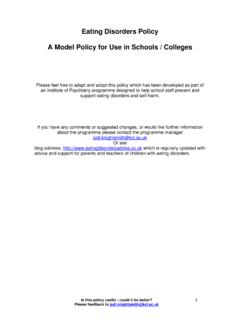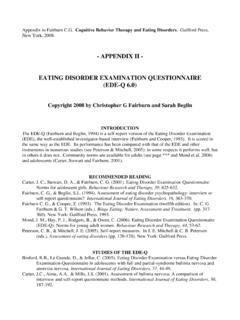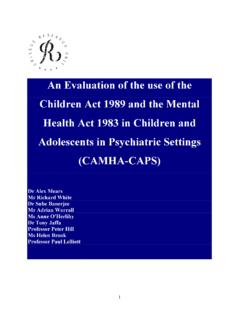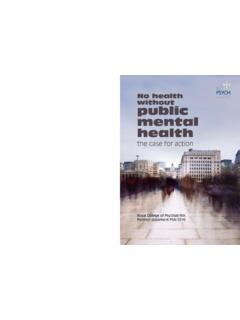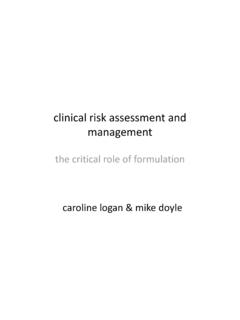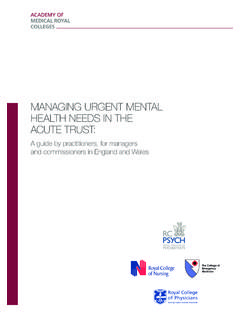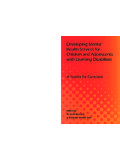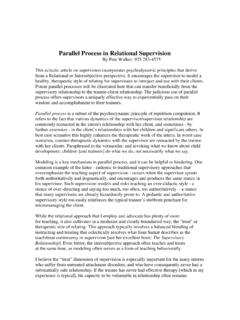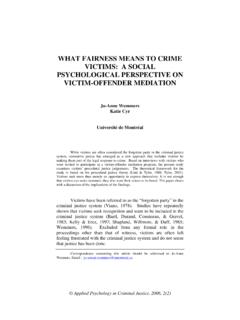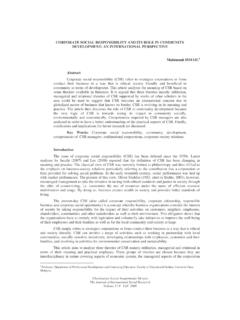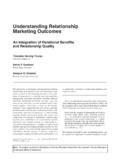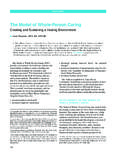Transcription of Your guide to relational security - Royal College of ...
1 your guide to relational security2nd EditionKeep everyone safe act on itKeep everyone safe act on it 1 Contentsintroduction 2 What is relational security ? 4team 6 Clear boundaries and purposeful therapyBoundaries 8 Therapy 12other patients 20 The effect of the mix of patients and the patient dynamicPatient mix 22 Patient dynamic 24inside world 30A patient s personal world and physical environment Personal world 32 Physical environment 34outside world 40 The impact of visitors and outward connectionsVisitors 42 Outward connections 44 Summary 50 Contact information 52 your feedback 53 I m delighted to introduce the second edition of See Think Act
2 On behalf of the Quality Network for Forensic Mental Health Services. When See Think Act was first published by the Department of Health in 2010, we took a significant step in our understanding of relational security . For the first time, we had a comprehensive explanation of the content behind the label and could see what we needed to do to get it right. Our second edition continues that journey. It continues to translate what people have learned in difficult situations into something simple and positive and does so in a way that s applicable for every part of the forensic pathway. Quazi Haque, Chair, Advisory Group, Quality network for Forensic Mental Health Services, Royal College of Psychiatrists This book is essential reading for anyone involved in secure mental health. It s an uncompromising explanation of what good-quality care looks like, and perhaps as importantly, what it doesn t look like. See Think Act is refreshingly candid in its style, leaving readers in no doubt at all about what they must do to provide high-quality care.
3 What I like most about this handbook is that it highlights the dependency between providing purposeful, thoughtful and considerate care and achieving services that are safe for everyone. It issues a loud and clear call to anyone who sees something that doesn t feel right, irrespective of his or her place in the system to Act. Paul Gilluley, national Professional Advisor in Forensic Mental Health, Care Quality Commission One of the many accomplishments of this book, from my perspective, is that it s written for staff at every level. It recognises how tough it can be to work in mental health services and provides us with some of the practical ideas and support we need to get this right. But at the same time, it demands an exacting standard from us and doesn t shy away from pointing out that positive services don t just need staff, they need staff who really want to make a difference. This book should be viewed as an important tool for nursing and healthcare worker professional development.
4 I can easily see how it might be used to support supervision, reflective practice and personal reflection. ian Hulatt, Professional Lead for Mental Health, Royal College of nursingPublished by the Royal College of Psychiatrists Quality Network for Forensic Mental Health Services. Written and edited by Elizabeth Allen. With thanks to: Providers of secure mental health services and their staff Patients, their friends, family and advocates The Care Quality Commission The Royal College of Nursing The Department of Health Commissioners of secure mental health services The National Oversight Group for high security hospitalsKeep everyone safe act on it 32 your guide to relational securityThis handbook is for people whowork in secure mental health your role is medical, nursing, administrative or domestic, it s important that you have the information you need to keepyourself, patients, colleagues and the public job is to provide people who need our services with high-quality care in a way that s purposeful, respectful and safe.
5 To do that, we need to understand the different elements that make up secure care and know how to respond if we think something is in secure services is rewarding but it s also hard work and highly demanding. On a daily basis, we manage a multitude of complex and sometimes emotionally challenging situations. Only by understanding how to work together to recognise and deal with risk can we create environments that are safe, hopeful and book has the information you need to understand what relational security is and learn how you can help keep everyone onAbout this bookthe purpose of this book is to help you understand what relational security really means and what you can do to ensure it s maintained in your place of explanation of relational security isn t just theoretical. It refl ects the collective learning of people in high, medium and low secure services. The examples of risk and measures of success you see described here refl ect the real experiences of people who work in these services and the people they care this book, we look at the main areas of relational security and think about some of the risks to patient care and security if we don t get it focus on the importance of talking as a team and understanding what s really going on.
6 We then explore what action you can take as an individual, as part of a team and as a leader and how you ll know if you re getting it book has been designed so you can keep it with you and use it whenever you want to refl ect on your thoughts about how relational security is working in your area. You can use it to help explain to other people, such as carers and patients, how relational security helps deliver good-quality care, or to refl ect on an experience or incident and think about how you want to solve it or what you might do differently next everyone safe act on itHOW TO USE THE EXPLORERGood relational security is the collectiveknowledge and understanding we have ofour patients and the actions we take to ensuresecurity and high-quality care. Everybody hasa responsibility for relational security . That swhy it s so important to talk as a team abouthow it feels and decide together how it canbe improved. 1 relational security ExplorerKeep everyone safe act on itYour guide to relational securityTEAMOTHER PATIENTSINSIDE WORLDOUTSIDE WORLDP atient mixPatientdynamicPersonalworldPhysicalen vironmentVisitorsOutwardconnectionsBound ariesTherapyDo we know our patient mix?
7 How does the ward dynamic feel for us and for patients?Do we know what s really going on on the ward?Do we feel in control?Do we talk enough about this?Do we know everything we need to about our patients?Do we know what the triggers are for all our patients?Can we spot when something is wrong?Do we talk to patients enough about how they are feeling? Does our ward environment help us to engage with patients?Is our ward tidy and well cared for?Do visitors know the rules?Do we talk to visitors enough before and after their visit? Do we have a plan for escorted leave?Do patients understand the consequence of absconding/escaping?Would we be able to spot plans to escape/abscond?Do we know what to do if something goes wrong?Do we have core values for the ward?Do we know what the boundaries are?Are we confi dent to speak up if someone is compromised?Are we engaging with patients enough?How do patients feel about their treatment and recovery? Are we positive role models?
8 Are we tackling discrimination, bullying and harassment?Check everyone understands all eight dimensions in the together what actions would improve each area, and how and when it s going to each of the dimensions in relation to your topic (for example, your ward, an incident or your own development). You can use the prompts in the shaded area or look at We know we re getting it right when: and Effective leaders: at the end of each section in your SEE THINK ACT you think it s useful you could rate the example:You can use the Explorer to support handover, for staff supervision, to investigate an incident or think about how a whole ward or service feels. Bring what you ve learned in SEE THINK ACT to the discussion, write in the middle of the circle what you re talking about and just get talking!TEAMOTHER PATIENTSINSIDE WORLDOUTSIDE WORLDP atient mixPati entdynamicPer sonalworl dPhysicalenvironmentVisitorsOutwardconne ctionsBoundariesTherapy1.
9 Very weak in this area we need to do a lot of work2. Fairly weak in this area there s still some way to go3. About halfway there4. Fairly good at this but there s more to do5. Great at this could help others everyone safe act on it 32 your guide to relational securityKeep everyone safe act on it 54 your guide to relational securitySecurity provides the framework withinwhich care and treatment can be safely provided. Neither patients nor staff can participate positively in the activities of the service unless they feel safe are three distinct but inter-related elements of security in a secure mental health setting. They are: relational security Procedural security (the policies and procedures in place to maintain safety and security ) Physical security (the fences, locks, personal alarms and so on that keep people safe).The balance between these three elements often shifts, requiring us to change our plans to meet the needs of a particular patient group or situation.
10 However, it s essential that all three are in place at all times, and one should never substantially compensate for the absence or ineffectiveness of is relational security ?What is relational security ? relational security is the knowledge and understanding we have of a patient and of the environment, and the translation of that information into appropriate responses and security is not simply about having a good relationship with a patient. Safe and effective relationships between staff and patients must be professional, therapeutic and purposeful, with understood limits. Limits enable staff to maintain their professional integrity and say no when boundaries are being this book we explore the four key areas that help staff maintain relational security . They are: the whole care team; the other patients on the ward; the inside world experienced by patients; and the connections those patients have with the outside diagram on this page shows each of these four areas of relational security divided in two to help you focus on what you and your team can do to gain a better understanding of relational security and take positive explore each of these eight dimensions, consider the risks involved and determine how we can act to keep everyone PATIENTSINSIDE WORLDOUTSIDE WORLDP atient mixPatientdynamicPerso nalworldPhysicalenvironmentVi sitorsOutwardconnectionsBoundariesTherap y4 your guide to relational securityKeep everyone safe act on it 76 your guide to relational securityPATIENTTEAMOTHER PATIENTSINSIDE WORLDOUTSIDE WORLDP atient mixPatientdynamicPerso nalworldPhysicalenvironmentVisitorsOutwa rdconnectionsBoundariesTherapyteamteamCl ear boundaries and purposeful therapyIn this section, we think about what it might feel like to be a patient in a secure service.
